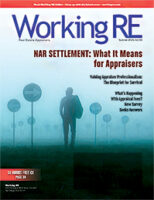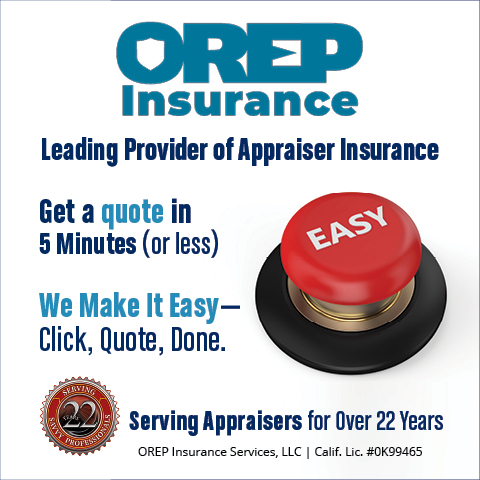 |
> The Appraiser Coach > AMC Resource Guide
> OREP E&O |
NAA President Malinda Griffin on Career, Advocacy, Barriers
by Tony Jones, Senior Editor
People find their way into “chosen” professions for all sorts of reasons, but for Malinda Griffin, MNAA, it was family. On a weekend visit to her parents’ house more than three decades ago, while sipping coffee on a porch overlooking Cold Mountain, North Carolina, Griffin’s father suggested she become a real estate appraiser.
At the time, Griffin, who is owner of Malinda Griffin & Co. in Simpsonville, South Carolina, and the newest president of the National Association of Appraisers (NAA), was in the midst of changing her career. Her motivation was to find something that would provide flexibility to spend time with her son, but she initially scoffed at her father’s suggestion because she didn’t want to be a real estate agent.
When she pushed back, her dad told her he was pretty sure appraisers no longer had to be Realtors. “I didn’t think he was right,” recalls Griffin, “but he’s always right. So, I came home, looked into it, and a couple of weeks later, I was signed up and started taking classes.”
Back then, all classes were live and in person, so she traveled back and forth to Columbia, South Carolina, from the Upstate (the northwesternmost area of the state) every weekend for about three months and passed the exam. This was also before appraisers had to first be a trainee.
“The category then was considered transitional license,” says Griffin. “So, you took the classes, passed the exam, hung your shingle out, and by golly, you were an appraiser.”
Living in a small town, Griffin attended church with several local loan officers and let them know she’d earned her appraiser’s license and was ready to help in any way she could. Her outreach was successful, and she soon began receiving work.
“The scariest day of my life was when I got that first order because I did not know what I was doing. It kind of fell into my lap,” she says. “They say the Lord works in mysterious ways, but he never lets you down.”
Steady Rise
Fast forward to today, Griffin has never looked back other than to appreciate the journey and use her early days in the profession to shape her perspective on the business and guide her principled approach to industry leadership. Since becoming a certified residential appraiser in 1992, she’s counted lending institutions, appraisal management companies, attorneys, accountants and others as clients. She’s also compiled an impressive list of industry-service roles along her path to the NAA presidency, including serving as president of the South Carolina Professional Appraisers Coalition (SCPAC) in 2020.
She recently sat down with Working RE to discuss her career, how the NAA serves the profession and some of the key dynamics affecting appraisers today.
Coalition Roots
Griffin believes wholeheartedly in the advocacy and professional-development aspects of industry organizations, from local chapters to the national level. She first became involved in her state chapter after receiving an invitation while taking a continuing education class.
Her initial state chapter membership led to serving on the board for a few years before that organization disbanded and morphed into SCPAC. Since its inception, she’s had a front row seat in helping shape the coalition’s efforts. This includes the push six years ago to establish SCPAC continuing education credit courses to elevate the coalition’s member services to match opportunities available at other state and national organizations.
“The easiest way to find out something is to just go do it—meet people and ask questions,” says Griffin. “When you do that, you meet some of the coolest people in the world. You learn, and then it’s like chocolate—you just want more, so you keep attending. Through that experience, I learned how to bring it home to my coalition here in South Carolina.”
Attending national conferences brought her in contact with speakers who were educating appraisers on big-picture topics. When Griffin began bringing them to South Carolina to present to coalition members, they acknowledged the work she was accomplishing at the state level and encouraged her to bring her energy and organization skills to a national platform.
“I saw myself as just a little person doing boots-on-the-ground work in the Upstate of South Carolina,” recalls Griffin. “But membership was at an all-time high. We were getting CE credit for our meetings. So, I said, ‘Well, you can nominate me, and if I get elected, I’ll do it.’ Three months later, I was putting on a suit and traveling to Bay St. Louis, Mississippi, to be installed as a director on the board for the National Association of Appraisers. And it has been a wonderful experience.”
After serving as vice president of NAA last year, Griffin was re-elected to the board this year, which enables her to serve the next three years. After serving as president this year, she has the option to take a second term in the lead role in 2025 before rolling into the past-president position.
Now in its 14th year, the NAA has grown from a charter with 10 to 12 members to a national association with nearly 2,200 members and several vendor partnerships. “I’m amazed at what this organization has done,” says Griffin.
(story continues below)
(story continues)
Lifting Appraisers
At its core, Griffin says the NAA is designed to advocate on behalf of appraiser interests and promote member awareness through education and information services. She believes engaged members who connect and network with colleagues and stay apprised of key issues that can impact them professionally puts them in a position to excel.
The problem is Griffin estimates that 60 to 70 percent of all appraisers aren’t affiliated with any association, which puts them at a distinct disadvantage. She believes so strongly in the power of appraisers working collectively in the same direction that she implores everyone to join at least one local or national association. “Be part of an organization, so that you have someone advocating for you on a local and/or national level,” says Griffin.
For Griffin and the NAA, the framework for advocacy goes beyond traveling to Washington, D.C., three times per year as part of The Appraisal Foundation Advisory Council, attending national events, leveraging key partnerships, and keeping a close eye on developments affecting the profession. “We want to have a seat at the table in as many areas as possible, so that we can not only advocate for appraisers, but bring relevant and the latest up-to-date information home to publish to our membership,” notes Griffin.
This raises the notion of self-advocacy by way of professional development. Being informed helps prevent costly mistakes in the field or when writing reports, just as pursuing certifications and gaining education beyond the 28-hour requisite for license renewal expands one’s knowledge base and marketability.
We’re certainly about professional development,” Griffin says in reference to the NAA. “We have an appraisal review certification that we offer, and we’ll soon be offering a litigation specialist certification. We’re also looking at a manufactured home specialist certification because in today’s world, people want to know that you’re specializing in things and that you know what’s needed, especially if you’re going be an expert witness. You don’t want to have completed only five appraisals in that category when you’re going to sit on the stand in front of a judge and say, ‘Hey, I’m an expert witness.’
“Getting certifications puts you above the norm because you’ve taken the extra measures to get that additional education.”
Career Pathways
Another area of advocacy the NAA is focused on is trying to create better avenues for those who want to become appraisers as well as those looking for advanced certification.
“A big-ticket item right now is barriers to enter the profession,” says Griffin. “PAREA [the Appraisal Institute’s Practical Applications of Real Estate Appraisal program] has been out for about a year now, and there have been some graduates. But even with PAREA graduates there are still some barriers to entry because you’ve got the experience hours to get your license, but you don’t have the experience hours to get a lender to put you on their panel.
“There are also barriers to entry for someone who wants to be a certified general appraiser because even someone like me who has 32 years of experience cannot move up without a bachelor’s degree,” she continues.
Griffin indicated the latter was a topic of discussion during a recent meeting of state organization leaders as well as an NAA board meeting and is hopeful some adjustments will eventually be made out of fairness to those who gain valuable experience while on the job; however, it is the decision of the Appraiser Qualifications Board.
“Experience hours count in every other profession toward education requirements, so why does it not count in ours,” she asks rhetorically. “I feel like you can be a good appraiser with the training that you take to become one. If you have a bachelor’s degree in something that’s totally unrelated, I don’t see how that contributes to your ability to be an appraiser.”
In addition to challenges to gain footing and advance careers, many appraisers have also been vocal about existential threats to the profession, chiefly fee compression and the rise of artificial intelligence, waivers and property data collectors. Though Griffin acknowledges these are factors impacting the sector, she doesn’t believe they’re enough to override what astute, diversified appraisers bring to the table.
“The appraisal profession is not going anywhere,” she asserts. “The GSEs just made a large investment to develop the Appraiser Diversity Initiative (ADI). They would not have made this investment, along with the Appraisal Institute, to create a program to bring people on if they were about to say, ‘Oh, we’re not going to order appraisals anymore.’ Appraisers will always be needed because even if a percentage of the properties qualify for a waiver, the remainder will need an appraisal.”
To help counterbalance the effects of sector stressors, Griffin encourages appraisers to consider private work and adding skills and services to their mix. “They haven’t found any kind of data set that can sit on a stand and testify about what you saw when you were out there or what the market conditions are. The judge wants a real person,” she notes.
Grateful for the Ride
Ultimately, Griffin believes appraisers are indispensable to the sales and valuation process. She’s grateful for the flexible lifestyle the profession has afforded her as well as that initial push her father gave her 30-plus years ago.
“I am thankful for the 32 years I have in. It’s been absolutely the best career that I could have ever hoped for,” says Griffin. “It allowed me to be a hands-on and present mom. It has allowed me to be a hands-on and present grandmother. Being able to be present in my son’s and grandsons’ lives is what I was made for.”
About the Author
Tony Jones is Senior Editor of Working RE magazine, published by OREP, a leading provider of E&O insurance for real estate professionals. Based in San Jose, California, he has nearly 30 years of business publishing experience and graduated with a bachelor’s degree in journalism from the University of Arizona. To reach him, email tony@orep.org.
OREP Insurance Services, LLC. Calif. License #0K99465




by the russian
self gratitude article… pat your self on the back.
-